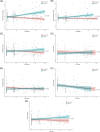Risk factors associated with disturbances of calcium homeostasis after initiation of a phosphate-restricted diet in cats with chronic kidney disease
- PMID: 33368694
- PMCID: PMC7848342
- DOI: 10.1111/jvim.15996
Risk factors associated with disturbances of calcium homeostasis after initiation of a phosphate-restricted diet in cats with chronic kidney disease
Abstract
Background: Dietary phosphate restriction improves survival in cats with chronic kidney disease (CKD). However, feeding a phosphate-restricted diet may disrupt calcium homeostasis leading to hypercalcemia in some cats.
Objectives: To identify risk factors associated with increasing plasma total calcium (tCa) concentration after transition to a phosphate-restricted diet and to explore its role in CKD-mineral and bone disorder (CKD-MBD) in cats.
Animals: Seventy-one geriatric (≥9 years) euthyroid client-owned cats with International Renal Interest Society (IRIS) stage 2 to 3 azotemic CKD.
Methods: Retrospective cross-sectional cohort study. Changes in plasma tCa concentration in the first 200 days of diet transition were assessed using linear regression. Binary logistic regressions were performed to identify risk factors for increasing calcium concentration. Changes in clinicopathological variables associated with CKD-MBD over time were explored using linear mixed model and generalized linear mixed model analyses.
Results: Lower baseline plasma potassium (odds ratio [OR] = 1.19 per 0.1 mmol/L decrease; P = .003) and phosphate (OR = 1.15 per 0.1 mmol/L decrease; P = .01) concentrations remained independent risk factors for increasing plasma tCa concentration. Plasma creatinine (β = .069 ± .029 mg/dL; P = .02), symmetric dimethylarginine (β = .64 ± .29 μg/dL; P = .03), phosphate (β = .129 ± .062 mg/dL; P = .04), and ln[FGF23] (β = .103 ± .035 pg/mL; P = .004) concentrations had significantly increased rates of change in cats with increasing plasma tCa concentration over time.
Conclusion and clinical importance: Lower plasma potassium or phosphate concentrations or both at the time of transition of cats with CKD to a phosphate-restricted diet are independently associated with increased risk of an increase in plasma tCa concentration. Increasing plasma tCa concentration is associated with progression of CKD.
Keywords: CKD-MBD; FGF23; feline; hypercalcemia; progression; renal diet.
© 2020 The Authors. Journal of Veterinary Internal Medicine published by Wiley Periodicals LLC. on behalf of the American College of Veterinary Internal Medicine.
Conflict of interest statement
P.‐K. T. received a PhD studentship funded by Royal Canin SAS. R. F. G. received funding from Petplan and an RVC Internal Grant; has a consultancy agreement with Boehringer Ingelheim; speaking honoraria from Boehringer Ingelheim. Y.‐M. C. declared no conflicts of interest. R. E. J. received funding from PetPlan, Feline Foundation for Renal Research, RVC Internal Grant, PetSavers, and consultancy agreements: Boehringer Ingelheim, CEVA. Speaking honoraria: Boehringer Ingelheim, Hills Pet Nutrition, CEVA. E. B. is employed by Royal Canin SAS. J. E. received funding from Consultancies: Elanco Ltd, CEVA Animal Health Ltd, Boehringer Ingelheim Ltd, Orion Incorp, Idexx Ltd, Nextvet Ltd, Waltham Petcare Science Institute, Kindred Biosciences Inc, Invetx Inc; grant funding from Elanco Ltd, Waltham Petcare Science Institute, Royal Canin SAS, Idexx Ltd, Zoetis Ltd, CEVA Animal Health, Member of the International Renal Interest Society which receives a grant from Elanco Ltd.
Figures



References
-
- Elliott J, Barber PJ. Feline chronic renal failure: clinical findings in 80 cases diagnosed between 1992 and 1995. J Small Anim Pract. 1998;39(2):78‐85. - PubMed
-
- Lulich JP, Osborne CA, O'Brien TD, Polzin DJ. Feline renal failure: questions, answers, questions. Compend Contin Educ. 1992;14(2):127‐153.
-
- Savary KC, Price GS, Vaden SL. Hypercalcemia in cats: a retrospective study of 71 cases (1991‐1997). J Vet Intern Med. 2000;14(2):184‐189. - PubMed
-
- Midkiff AM, Chew DJ, Randolph JF, Center SA, DiBartola SP. Idiopathic hypercalcemia in cats. J Vet Intern Med. 2000;14(6):619‐626. - PubMed
MeSH terms
Substances
Grants and funding
LinkOut - more resources
Full Text Sources
Medical
Miscellaneous

